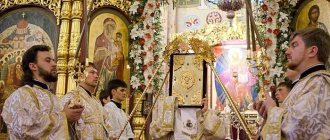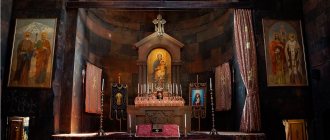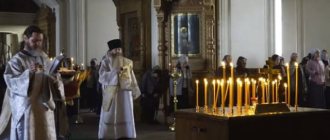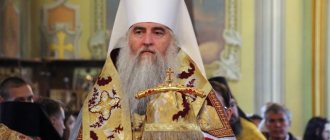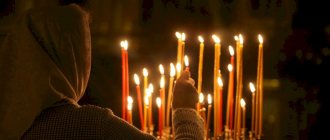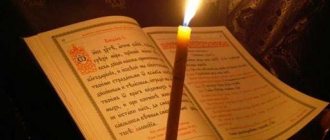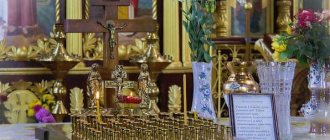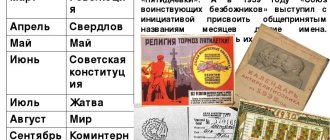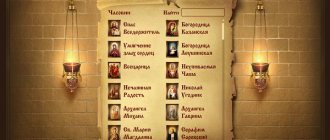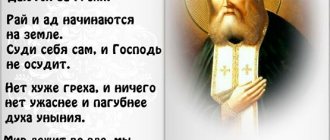Liturgy takes place in every church
The Divine Liturgy is the central service, since during it the Sacrament of the Eucharist and the Sacrament occur (or rather, the Liturgy itself accompanies these Sacraments). All other services in one way or another precede the Liturgy - although they can take place the night before or even earlier.
photo: patriarchia.ru
Liturgy takes place at least every Sunday
The regularity of services depends on the temple: the location where the temple is located and the number of parishioners. In other words, the Liturgy takes place in the church as often as is actually needed.
For example, in monasteries, services are held every day: since the meaning of the monastery for its monastic inhabitants is to serve God, and the Liturgy for them is not a duty, but life.
In some non-monastic churches, Liturgies may also be served daily.
In rural and small city churches, the Liturgy, as a rule, is celebrated at least once a week (on Sunday) and on major Church holidays.
Liturgy is served in the morning
When does the Liturgy begin? The starting time may also vary from temple to temple. But, as a rule, the service begins no earlier than seven in the morning and no later than ten.
For example, at the Moscow Compound of the Holy Trinity Sergius Lavra in Moscow, the Liturgy schedule is as follows:
- weekdays and Saturday - Liturgy begins at 8 am;
- On Sundays and days of major Church holidays, two liturgies are held: early at 7 am and late at 9 am.
In any case, the in-person schedule of services can always be found on the temple website or on its territory.
Trinity Church. Moscow Compound of the Holy Trinity Sergius Lavra in Moscow
Features of worship services
The peculiarity of the organization of divine services depends on the priest leading the church. For example, Vespers and Matins in villages are organized exclusively by large churches and cathedrals. The difference may lie in the timing and duration of the service. The main liturgical event of any church is the liturgy. At this time, a prayer is read, all parishioners and clergy remember Christ. The liturgy ends with an invitation to pass through the sacrament of Communion. It takes place between 6 and 9 am.
On Sundays there is one service called the Eucharistic. All services are combined into a single one, replacing one another. A recent change in the provisions of the church charter established the holding of Compline exclusively during the beginning of Lent. In addition to large services, the Orthodox Church accepts parallel rituals and sacraments, reading prayer books and akathists.
And sometimes Liturgies are served at night
Night liturgies take place on the most important Christian holidays - Easter and Christmas. There are other exceptions. For example, at the same Moscow Compound of the Holy Trinity Sergius Lavra, the night Liturgy takes place on the day of the celebration of the icon of the Most Holy Theotokos “It Is Worthy to Eat” - in the temple there is this revered icon of the Mother of God, which was brought from Athos.
Icon of the Mother of God “It is Worthy to Eat” at the Moscow Compound of the Holy Trinity Sergius Lavra
How long does the liturgy last in church?
The duration of the liturgy may vary depending on the day or temple. But this does not mean that the composition of the service changes radically. For example, on especially solemn days, part of the prayers, which are sometimes read by the reader, are this time sung in chorus.
In addition, how long the liturgy lasts can be influenced by such seemingly insignificant factors as the speed with which the priest and deacon serve: one leads the services faster, the other slower, one reads the Gospel at the same pace, the other more measuredly . And so on.
But speaking in general terms, on the days of the Great Holidays the Liturgy lasts longer than on ordinary ones - sometimes up to two hours.
On Easter night or Christmas Liturgy lasts no longer than usual, but the night service itself turns out to be many hours - since the Liturgy is preceded by a long All-Night Vigil.
Night service in the Cathedral of Christ the Savior, photo: patriarchia.ru
Christian Foundations of the Eucharist
Two thousand years ago, Christ at the Last Supper left the commandment to take communion in memory of Him, eating bread and wine. Modern Christians partake of His Blood through this sacrament performed during the Divine Liturgy.
The Divine Liturgy is the most important service
In former times, the Great Service was called mass, Catholics celebrate the sacrament at mass.
The first Christians in Jewish society were perceived as a sect, and therefore were persecuted. Carrying the gospel of Christ into the world, talking about the meaning of the Eucharist, the disciples of Jesus were constantly under attack from society, so their services were often held under the veil of secrecy.
After ministering to the pagans, the Apostle Paul defended the proposal to allow newly converted pagans to receive communion without observing the law of Moses on circumcision. At the first services, psalms were read almost daily, sermons were spoken, prayers were sung, and all services ended with the remembrance of the Last Supper. At common prayers, Christians broke bread and took wine every day, remembering the earthly life of the Savior.
Read about the Orthodox Church:
- What types of Orthodox monasteries are there?
- Why and for what does the church collect money?
- Who is a vicar in the Orthodox Church
This action will later be called the Eucharist, which is the central part of the Divine ministry. Unlike Jews, Christians:
- refused blood sacrifices, accepting the one and final sacrifice, God's Lamb, Jesus Christ;
- can ordain any person on earth who has converted to Christianity, and not just the descendants of Aaron;
- the whole world is chosen as a place of service;
- prayer services can be held both during the day and at night;
- hours were introduced during the service.
What time does morning service start in church?
On the one hand, the answer to this question is most often the same as to the question: “What time does the Liturgy begin,” since in almost all non-monastic churches the only morning service is the Liturgy.
Another thing is that in some churches (where there is only one priest), confession sometimes takes place not during the service, but before it, and therefore those who want to confess or take communion come earlier.
But in monasteries, morning services begin much earlier, since a full daily cycle of services is held there.
For example, before the liturgy in monasteries, the Hours are necessarily read (this is a small service that includes the reading of certain prayers and individual psalms), and on most days a midnight office is also served, which can begin at 6 a.m. or earlier.
In addition, the charter of some monasteries also stipulates, for example, the daily morning reading of akathists, and a prayer rule, which will also take place in the temple. Therefore, in some monasteries, morning services, in fact, stretch for several hours, and the Liturgy, as expected, crowns this cycle.
This does not mean that the laity receiving communion need to be present at all monastic services - they are intended primarily for the inhabitants of the monastery (monks, novices and laborers). The main thing is to come to the beginning of the Liturgy.
Orthodox Life
Proskomedia, Liturgy of the Catechumens, antiphon and litany - what all these words mean, says Archimandrite Nazariy (Omelyanenko), a teacher at the Kyiv Theological Academy.
– Father, the Liturgy of John Chrysostom is celebrated in the Orthodox Church throughout the year, except for Great Lent, when it is served on Saturdays, on the Annunciation of the Most Holy Theotokos and on the Week of Vaiya. When did the Liturgy of John Chrysostom appear? And what does the word “Liturgy” mean?
– The word “Liturgy” is translated from Greek as “common cause.” This is the most important divine service of the daily cycle, during which the Eucharist is celebrated. After the Lord ascended to Heaven, the apostles began to perform the Sacrament of Communion every day, while reading prayers, psalms and Holy Scripture. The first rite of the Liturgy was compiled by the Apostle James, the brother of the Lord. In the Ancient Church there were many rites of the Liturgy on the territory of the Roman Empire, which were unified during the 4th–7th centuries and are now used in the same form in the Orthodox Church. The Liturgy of John Chrysostom, which is celebrated more often than others, is an independent creation of the saint based on the text of the Anaphora of the Apostle James. The Liturgy of Basil the Great is served only 10 times a year (5 Sundays of Great Lent, Maundy Thursday, Holy Saturday, Christmas and Epiphany Eves, the day of remembrance of the saint) and represents an abbreviated version of the Liturgy of James. Third Liturgy of the Presanctified Gifts, the edition of which is attributed to St. Gregory the Dvoeslov, Bishop of Rome. This Liturgy is celebrated only during Lent: on Wednesday and Friday, on Thursday of the fifth week, in the first three days of Holy Week.
– The Liturgy consists of three parts. The first part is proskomedia. What happens during proskomedia in the church?
– “Proskomedia” is translated as “offering.” This is the first part of the Liturgy, during which the preparation of bread and wine is carried out for the celebration of the Sacrament of the Eucharist. Initially, proskomedia consisted of the procedure of choosing the best bread and dissolving wine with water. It should be noted that these substances were brought by Christians themselves to perform the Sacrament. Since the 4th century, the circumcision of the Lamb - the Eucharistic bread - has appeared. From the 7th to 9th centuries, proskomedia gradually developed as a complex ritual sequence with the removal of many particles. Accordingly, the location of the proskomedia during worship has changed in historical retrospect. At first it was performed before the Great Entrance, later, with the development of the rite, it was brought to the beginning of the Liturgy for reverent celebration. Bread for proskomedia must be fresh, clean, wheat, well mixed and prepared with sourdough. After the church reform of Patriarch Nikon, five prosphoras began to be used for proskomedia (before the reform, the Liturgy was served on seven prosphoras) in memory of the Gospel miracle of Christ feeding five thousand people with five loaves. In appearance, the prosphora should be round and two-part in commemoration of the two natures of Jesus Christ. To remove the Lamb, a prosphora with a special seal on top in the form of a cross sign is used, separating the inscription: ΙС ХС НИ КА - “Jesus Christ conquers.” Wine for proskomedia must be natural grape, without impurities, red in color.
During the removal of the Lamb and the pouring of dissolved wine into the chalice, the priest pronounces words of prophecy and Gospel quotes about the passion and death of the Savior on the cross. Next, particles are removed for the Mother of God, saints, living and deceased. All particles are displayed on the paten in such a way as to visibly indicate the fullness of the Church of Christ (earthly and heavenly), the head of which is Christ.
– The second part of the Liturgy is called the Liturgy of the Catechumens. Where did this name come from?
– The Liturgy of the Catechumens is indeed the second part of the Liturgy. This part received this name because at that moment the catechumens—people who were preparing to receive Baptism and were undergoing catechesis—could pray in the church together with the faithful. In ancient times, the catechumens stood in the vestibule and gradually became accustomed to Christian worship. This part is also called the Liturgy of the Word, since the central point is the reading of the Holy Scriptures and the sermon. The reading of the Apostle and the Gospel conveys to believers the life and teaching of Christ about God, and the incense between the readings symbolizes the spread of grace on earth after the preaching of Christ and the apostles.
– When are antiphons sung? What it is?
– During the divine service of the Orthodox Church, prayers can be sung antiphonally, that is, alternately. The principle of singing psalms antiphonally in the Eastern Church was introduced by the Hieromartyr Ignatius the God-Bearer, and in the Western Church by Saint Ambrose of Milan. There are two types of antiphons, which are performed at Matins and at Liturgy. Powerful antiphons at Matins are used only at the All-Night Vigil; they are written based on the 18th kathisma in imitation of the Old Testament singing on the steps when ascending to the Jerusalem Temple. At the Liturgy, antiphons are divided into everyday antiphons (91st, 92nd, 94th psalms), which received their name from their use during the daily service; figurative (102nd, 145th psalms, blessed) are called so because they are taken from the Sequence of figurative; and festive ones, which are used on the Lord's twelve feasts and Easter and consisting of verses of selected psalms. According to the Typicon, there is also the concept of antiphons of the Psalter, that is, the division of kathisma into three “glories,” which are called antiphons.
– What is a litany and what are they?
– Litany, translated from Greek as “prolonged prayer”, is the petition of a deacon with the choir singing alternately and the final exclamation of the priest. There are the following types of litanies: great (peaceful), deep, small, petitionary, funeral, about the catechumens, lithium, final (at the end of Compline and Midnight Office). There are also litanies at various prayer services, Sacraments, services, monastic tonsures, and consecrations. In essence, they have the structure of the above litanies, only they have additional petitions.
– The third part of the Liturgy is the Liturgy of the Faithful. Is this the most important part?
– The Liturgy of the Faithful is so called because only the faithful can attend it. Another name is the Liturgy of Sacrifice, since the central place is the offering of the Bloodless Sacrifice, the celebration of the Eucharist. This is the most important part of the Liturgy. At the beginning of this part, the Cherubic Song and the Great Entrance are sung, during which the Holy Gifts are transferred from the altar to the throne. Next, before the Anaphora (Eucharistic Prayer), all believers together pronounce the Creed, testifying to the unity of the confession of the Orthodox faith. During the Anaphora, the priest pronounces secret prayers calling on the Holy Spirit to sanctify those praying and offer the Holy Gifts. The Liturgy of the Faithful ends with the general communion of clergy and believers, in which the conciliarity and unity of Christ’s Church is visibly evidenced.
Interviewed by Natalya Goroshkova
